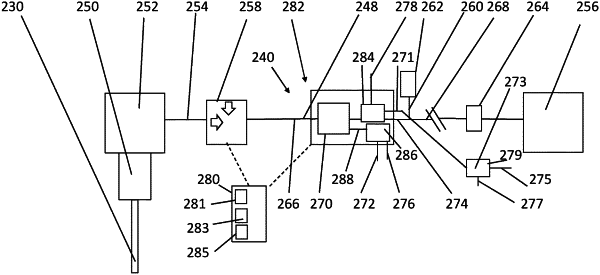| CPC E21B 43/12 (2013.01) [E21B 43/35 (2020.05)] | 17 Claims |

|
1. A method of controlling sand production from an oil well, the method comprising the steps of:
(a) providing a continuous output production flow from a wellhead of an oil well connected to an oil-containing reservoir, the output production flow comprising hydrocarbon-containing oil at an oil production rate and sand at a sand production rate, and the output production flow being conveyed by a pipeline from the wellhead to a facility for processing, transporting by pipeline, or storing the oil;
(b) at a sand management station along the pipeline between the wellhead and the facility, passing the output production flow through a sand management system installed in the pipeline, wherein the sand management system comprises a solids separator configured to separate sand from the oil of the output production flow, wherein the sand management system has an input which receives the output production flow from the wellhead along an upstream part of the pipeline, the upstream part being upstream of the sand management system, and an oil output which outputs the oil, having sand separated therefrom, along a downstream part of the pipeline, the downstream part being downstream of the sand management system;
(c) opening a choke of the wellhead to increase the oil production rate and sand production rate, whereby the sand production rate is increased to a level higher than a value of an allowable sand rate (ASR) which is a predetermined maximum threshold sand production rate of the pipeline, and, at least during a time period when the sand production rate is higher than the allowable sand rate (ASR), continuously or continually separating sand in the output production flow from the oil of the output production flow using the solids separator of the sand management system to provide a zero or non-zero reduced sand flow in the downstream part of the pipeline;
(d) after or during step c), measuring sand flow in at least one of the sand management system or the downstream part of the pipeline to provide a value of a reduced sand flow rate, which is a flow rate of the reduced sand flow in the downstream part of the pipeline;
(e) comparing the value of the reduced sand flow rate with the value of the allowable sand rate (ASR) to provide a sand rate comparison value; and
(f) controlling the oil production rate using the sand rate comparison value to maintain the reduced sand flow rate in the downstream part of the pipeline below the allowable sand rate (ASR);
wherein the sand management system is temporarily installed in the pipeline for a series of intermittent time periods, each intermittent time period comprising a test period during which the sand management system is operational to separate sand from the oil production, and the sequence of the combination of steps b), c), d), e) and f) is carried out during the test period, and
wherein the method further comprises the steps, after step c) and during the test period, of (I) closing the choke of the wellhead to decrease the oil production rate and sand production rate; (II) measuring the decreased reduced sand flow rate in the pipeline to provide a measured decreased reduced sand flow rate, (III) comparing the measured decreased reduced sand flow rate and the allowable sand rate (ASR) to determine the sand rate comparison value to confirm that the measured decreased reduced sand flow rate is no greater than the allowable sand rate (ASR); (IV) setting the oil production rate to a set production rate corresponding to the decreased oil production rate; and (V) terminating the test period.
|